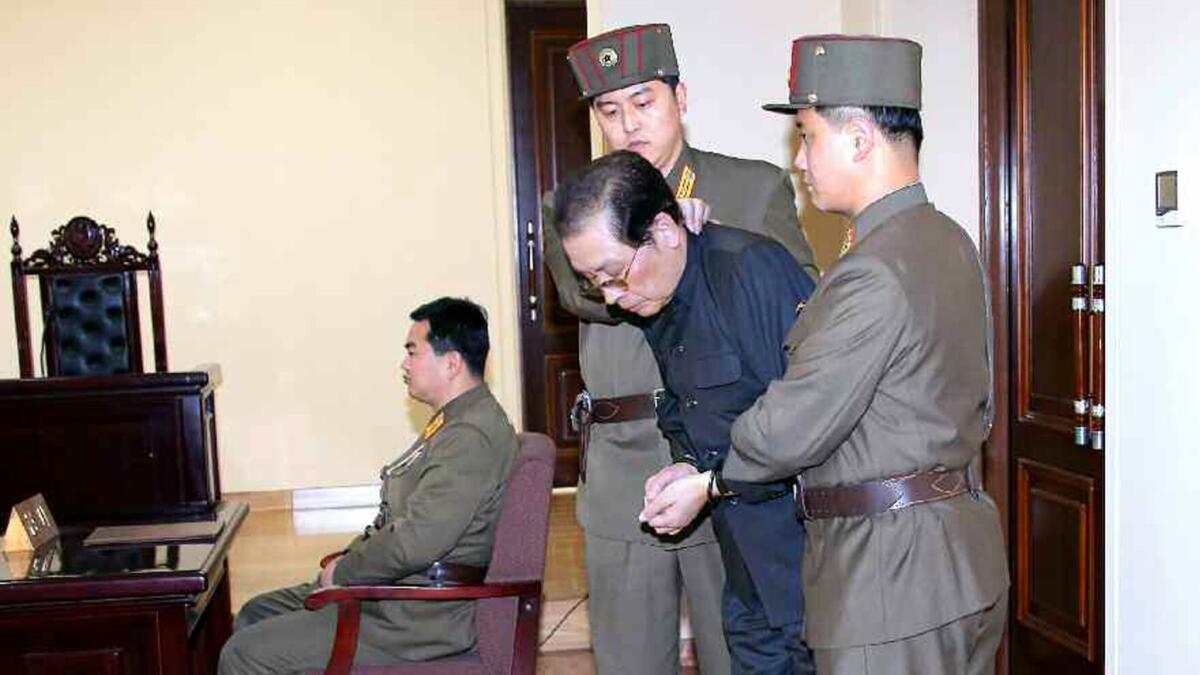Eyewitnesses help document public executions in North Korea for a day of reckoning

- Share via
Reporting from SEOUL — As a boy of about 9 or 10, Kang Chun Hyok waded between grown-ups’ legs and made his way to the front of a crowd of hundreds assembled near a brick factory in his hometown, not far from North Korea’s border with China.
Six soldiers aimed their rifles at the condemned man, who looked like he could barely walk. Each fired three shots, and then it was over. The man’s crime: stealing copper wires from state-owned power lines.
“I was curious, and wanted to pick up shell casings. But I was shocked,” recalled Kang, now 33, who fled North Korea in 1998 and lives in Seoul. “The scene was so real; I was so young.”
He’s far from alone. Four in 5 North Korean escapees interviewed for a new report by a South Korea-based research group said they had witnessed a public execution in their lifetime. More than half said they’d been forced to watch one.
Ever since President Trump’s dramatic pivot to personal diplomacy with North Korean leader Kim Jong Un in early 2018, both U.S. and South Korean officials have tiptoed around mentioning the North Korean government’s human rights record for fear of upending talks. Even with the negotiations indefinitely on ice since February’s summit in Hanoi, both governments have continued to shy away from the topic.
All the while, a group in South Korea has been laying the groundwork for a day when the North Korean government will have to account for acts that the United Nations has called crimes against humanity. As in post-apartheid South Africa and the former Yugoslavia, researchers are betting there will come a day of reckoning before international law for North Korea’s leaders.
The new report by the Seoul-based nonprofit Transitional Justice Working Group, based on interviews with more than 600 escapees, attempts to prepare for the eventual legal proceedings by counting the skeletons in North Korea’s closet — identifying and mapping more than 300 public executions and dozens of burial sites wherein lie those killed by the state.
In a sign that the government may be sensitive to how the executions are viewed by the outside world, two of the escapees said guards used handheld metal detectors to seize cellphones from those in the audience in 2013 or 2014, according to the report.
The continued practice of public executions is a key tool through which North Korea maintains control over its people, said research director Sarah Son, one of the report’s authors.
“It’s a clear tactic, it serves a purpose,” she said. “It maintains that culture of fear, it asserts regime control, it reminds people that certain crimes are not tolerated.”

Along with Iran and Saudi Arabia, North Korea is one of the few nations that continue to conduct public executions. North Korea previously acknowledged to the United Nations that public executions do take place but “only in exceptional cases, where the crime committed was exceptionally grave.”
The report found that the most common infraction for which people were executed was property crime — stealing copper from power lines or theft of livestock, especially cows. Of the 715 charges documented in the report, 238 cases involved theft or damage to property while 115 cases were for violent crimes including murder and rape. Many others reported seeing executions for political crimes or for watching South Korean media.
Under North Korean criminal laws, “extremely severe cases of theft of state property” are punishable by death.
The vast majority were executed by firing squad, with a small number of reported hangings, which appear to have been largely discontinued since 2005, according to the report. The most common sites of public executions were riverbanks, fields and other open spaces, often with hundreds but sometimes more than 1,000 watching.
Without access to North Korea or any of its official records, researchers had to rely on the memories of escapees who volunteered to be interviewed. Because it takes years for North Koreans who flee to China to make their way to South Korea, the most recent documented execution dates to 2015, making it impossible to know whether there have been changes amid talks with the United States.
South Korean leader’s visit highlights Trump’s stalled nuclear talks with Kim Jong Un »
A separate report released last week by the South Korean government-affiliated Korea Institute for National Unification found that based on anecdotal accounts, public executions continued to take place in 2018, but they may have become less frequent.
Researchers have also been documenting suspected mass graves where remains of the condemned may be buried, using satellite images and retracing escapees’ memories, to help with any future prosecutions or tribunals.
In 2014, a U.N. Commission of Inquiry on Human Rights in North Korea warned leader Kim in a letter that, under international law, military commanders and civilian superiors can be held accountable for abuses committed under their rule.
The letter accompanied a 400-page report that documented crimes against humanity taking place in North Korea, including “extermination, murder, enslavement, torture, imprisonment, rape, forced abortions and other sexual violence, persecution on political, religious, racial and gender grounds, the forcible transfer of populations, the enforced disappearance of persons and the inhumane act of knowingly causing prolonged starvation.”
Some of the escapees interviewed for the report, though, had a simpler reason for why the bodies of those executed by the state should be located and exhumed: “The dead bodies should be returned to their families as the dead are human beings.”
More to Read
Sign up for Essential California
The most important California stories and recommendations in your inbox every morning.
You may occasionally receive promotional content from the Los Angeles Times.











